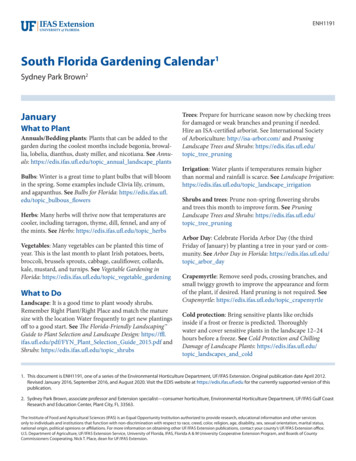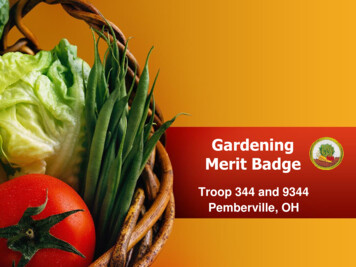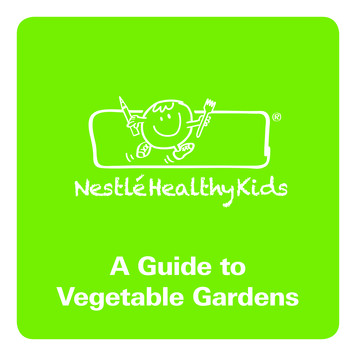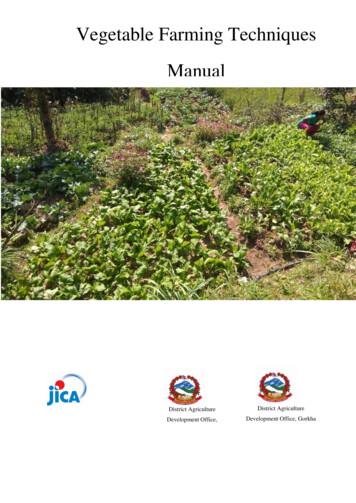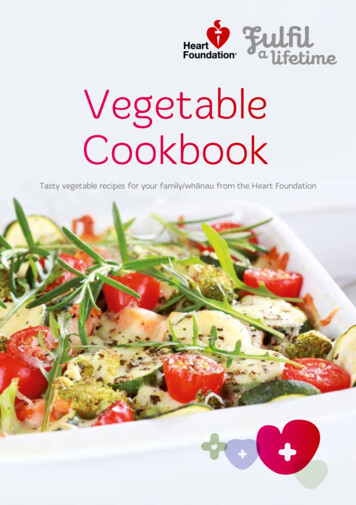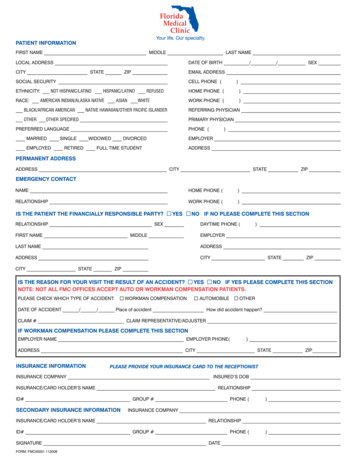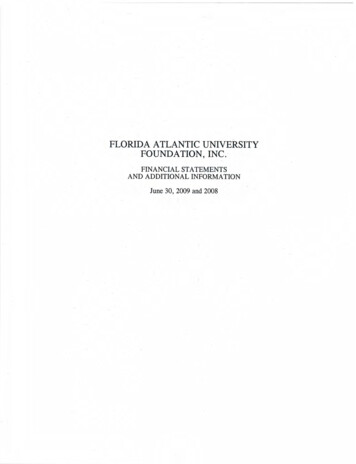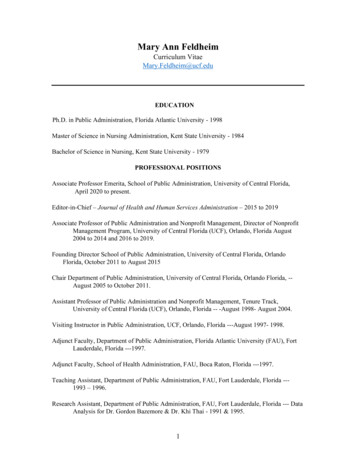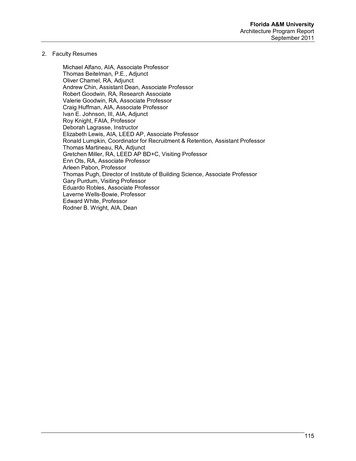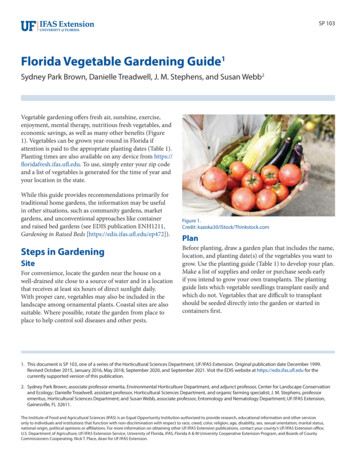
Transcription
SP 103Florida Vegetable Gardening Guide1Sydney Park Brown, Danielle Treadwell, J. M. Stephens, and Susan Webb2Vegetable gardening offers fresh air, sunshine, exercise,enjoyment, mental therapy, nutritious fresh vegetables, andeconomic savings, as well as many other benefits (Figure1). Vegetables can be grown year-round in Florida ifattention is paid to the appropriate planting dates (Table 1).Planting times are also available on any device from https://floridafresh.ifas.ufl.edu. To use, simply enter your zip codeand a list of vegetables is generated for the time of year andyour location in the state.While this guide provides recommendations primarily fortraditional home gardens, the information may be usefulin other situations, such as community gardens, marketgardens, and unconventional approaches like containerand raised bed gardens (see EDIS publication ENH1211,Gardening in Raised Beds [https://edis.ifas.ufl.edu/ep472]).Steps in GardeningSiteFor convenience, locate the garden near the house on awell-drained site close to a source of water and in a locationthat receives at least six hours of direct sunlight daily.With proper care, vegetables may also be included in thelandscape among ornamental plants. Coastal sites are alsosuitable. Where possible, rotate the garden from place toplace to help control soil diseases and other pests.Figure 1.Credit: kazoka30/iStock/Thinkstock.comPlanBefore planting, draw a garden plan that includes the name,location, and planting date(s) of the vegetables you want togrow. Use the planting guide (Table 1) to develop your plan.Make a list of supplies and order or purchase seeds earlyif you intend to grow your own transplants. The plantingguide lists which vegetable seedlings transplant easily andwhich do not. Vegetables that are difficult to transplantshould be seeded directly into the garden or started incontainers first.1. This document is SP 103, one of a series of the Horticultural Sciences Department, UF/IFAS Extension. Original publication date December 1999.Revised October 2015, January 2016, May 2018, September 2020, and September 2021. Visit the EDIS website at https://edis.ifas.ufl.edu for thecurrently supported version of this publication.2. Sydney Park Brown, associate professor emerita, Environmental Horticulture Department, and adjunct professor, Center for Landscape Conservationand Ecology; Danielle Treadwell, assistant professor, Horticultural Sciences Department, and organic farming specialist; J. M. Stephens, professoremeritus, Horticultural Sciences Department; and Susan Webb, associate professor, Entomology and Nematology Department; UF/IFAS Extension,Gainesville, FL 32611.The Institute of Food and Agricultural Sciences (IFAS) is an Equal Opportunity Institution authorized to provide research, educational information and other servicesonly to individuals and institutions that function with non-discrimination with respect to race, creed, color, religion, age, disability, sex, sexual orientation, marital status,national origin, political opinions or affiliations. For more information on obtaining other UF/IFAS Extension publications, contact your county’s UF/IFAS Extension office.U.S. Department of Agriculture, UF/IFAS Extension Service, University of Florida, IFAS, Florida A & M University Cooperative Extension Program, and Boards of CountyCommissioners Cooperating. Nick T. Place, dean for UF/IFAS Extension.
Soil PreparationGardeners often plant on whatever soil type is available,but it is usually worthwhile to improve the garden plot withadditions of organic matter (see below). Spade or plow theplot at least three weeks before planting. At planting time,rework the soil into a smooth, firm surface.ORGANIC MATTERMost Florida soils are low in organic matter and thereforebenefit from the addition of organic matter such as animalmanure, rotted leaves, compost, commercial soil mixes,and/or cover crops. Composted organics may be applied atplanting time; un-composted organics (such as fresh grassclippings) should be mixed into the soil at least a monthbefore seeding. Due to low and inconsistent levels of nutrients in compost, accompanying applications of inorganicor organic fertilizer may be beneficial (See “Fertilizing”below). Thoroughly mix liberal amounts of un-compostedorganics in the soil well in advance of planting, preferablyat least a month before seeding. Animal manure if usedshould be spread at a rate of 25–100 pounds per 100 squarefeet and should be worked into the soil 90–120 days beforeharvesting any vegetables. See EDIS publication HS1215,Organic Vegetable Gardening in Florida (https://edis.ifas.ufl.edu/hs1215).COMPOSTCreate your own “garden gold” by converting yard wastesto compost (Figure 2). Composting is easy to do andyields a manure-like, organic fertilizer/soil conditioner,which highly benefits Florida’s infertile native soils. SeeEDIS publication ENH 1065, Compost Tips for the HomeGardener (https://edis.ifas.ufl.edu/EP323).1. Buy a compost unit or build one from recycled woodpallets, concrete block, sturdy wire, etc. The minimumsize should be 3’ 3’ 3’.2. Make successive, 12-inch-thick layers of plant waste—such as leaves, lawn clippings, shredded branches, andwood chips. Kitchen scraps may also be used.3. Animal (not pet) manure, finished compost, blood meal,or fertilizer can be added to each layer if desired.4. Moisten each layer and keep the pile moist.5. Turn the pile frequently to add oxygen and help thedecomposition process.6. Depending on how intensively it is managed, compostshould be ready for use in two to twelve months, whenplant parts are decomposed.7. Cover the pile to keep rain from leaching nutrients fromit.COVER CROPS (GREEN MANURE)Cover crops can be planted in off-seasons to suppresserosion, weeds, or nematodes. The following cover cropsare recommended for Florida gardens: Summer: cowpea, velvet bean, soybean, and sunflower Winter: cereal rye (FL 401), crimson clover, and Austrianwinter peaWhen a cover crop is turned into the soil, the decayingorganic matter (green manure) supplies organic matter andnutrients. Some cover crops can also suppress nematodes.For more information, see EDIS publications ENY012,Nematode Management in the Vegetable Garden (https://edis.ifas.ufl.edu/NG005) and ENY059, Soil Organic Matter,Green Manures, and Cover Crops For Nematode Management (https://edis.ifas.ufl.edu/vh037).ADJUSTING SOIL PHSoil pH is important because it determines how availablenutrients are to plants. The best pH range for vegetablegardens on sandy soil is between pH 5.8 and 6.3. If your soilpH is between 5.5 and 7.0, no adjustment in pH needs to bemade.Figure 2.Credit: UF/IFASFlorida Vegetable Gardening GuideIf your soil pH is below 5.5, apply lime at a rate recommended by a reliable soil testing facility, such as the UF/IFAS Extension Soil Testing Laboratory (http://soilslab.ifas.2
ufl.edu/). Two to three pounds of finely ground dolomiticlimestone per 100 square feet will usually raise the pH onepoint. Caution: Application of lime when it is not neededmay cause plant nutritional problems. Lime is best appliedtwo to three months before the garden is to be planted.However, lime may be applied as late as one or two weeksbefore planting. Make sure the lime is thoroughly mixedinto the soil to a depth of 6 of 8 inches, then water the soilto promote the chemical reaction.If your soil pH is naturally above 7.0 (alkaline), wherelimestone, marl, or shells are present, there is no practicalway of permanently lowering soil pH. Additions of acidicorganic matter will help, but only temporarily. Use afertilizer that contains micronutrients. If the high pH isthe result of previous over-liming, application of granularsulfur (1 lb/100 sq ft) will lower soil pH.FertilizingUnless very large quantities of organic matter are applied,commercial synthetic fertilizer is usually needed for Floridagardens. Gardeners find it convenient to use commonlyavailable fertilizer grades such as 10-10-10. However, someFlorida soils contain adequate phosphorus (the middlenumber), and additional amounts should not be added asphosphorus is a pollutant in surface water such as lakes andrivers. A soil test will provide guidelines for the amount ofphosphorus and other nutrients to apply. See EDIS publication Cir 1248, UF/IFAS Extension Soil Testing view/126879).Using the amount of fertilizer recommended on the product or based on your soil test results, broadcast fertilizerover the entire garden plot just before planting. During thegrowing season, 2 or 3 light applications of fertilizer canbe applied as needed. Apply the fertilizer just beyond theoutside leaves. Leafy vegetables such as lettuce, kale, andcollards benefit from side dressings of nitrogen-containingfertilizer such as ammonium nitrate. Tuber and root crops,like carrots and potatoes, respond to potassium fertilizersuch as muriate of potash.More information on organic fertilizers and nutrientmanagement can be found in EDIS publication HS1215,Organic Vegetable Gardening in Florida (https://edis.ifas.ufl.edu/hs1215).Irrigation and Drainagesoil moisture to grow and produce. Frequency of irrigationdepends upon the age of the crop and your soil type.Young plants need frequent but light irrigation; maturingcrops need more water but less often. Sandy soils demandmore frequent irrigation than clay, muck, or amendedsoils. Conserve water by using mulch, organic matter, andtechniques such as drip irrigation. Make a slight depressionat the base of plants to hold water until absorbed by the soil.Extending the Gardening SeasonGardeners can extend the growing season with protectivecovers and structures that reduce plant stress and damagefrom hot and cold temperatures. Commercial growers useshade houses, high tunnels, and row covers; gardeners canadopt modifications of these approaches (Figure 3). Tolearn more, see the EDIS publications Veggies and HerbsMade in the Shade (https://edis.ifas.ufl.edu/hs1228) andRow Covers for Growth Enhancement (https://edis.ifas.ufl.edu/cv106). Remove covers when plants that need bees forpollination begin to flower (see vegetables listed in Table 1as members of the Squash/Cucurbitacae family).Figure 3.Credit: UF/IFASPest ManagementPests in the vegetable garden include weeds, insects, mites,diseases, nematodes, and even animals such as raccoonsand birds that might consume the vegetable crop (seehttps://edis.ifas.ufl.edu/VH036).A gardener has many options for reducing pest problems(https://edis.ifas.ufl.edu/in197). Pesticides can be harmful to people, pets, beneficial insects, and the naturalenvironment and should be used only after all otherpest-management steps have been taken.Vegetables cannot tolerate standing water from excessiverainfall or irrigation. At the same time, vegetables needFlorida Vegetable Gardening Guide3
No-Pesticide Approaches Follow recommended planting date(s) listed for eachvegetable in Table 1. However, be aware that vegetablesplanted in late summer or early fall (August or September) will be susceptible to insects and diseases that thrivein hot weather. Likewise, cold-tender vegetables plantedin late winter or early spring may be damaged by frostsor freezes if not protected with covers (see “Extendingthe Gardening Season” above for more information oncovers). Rotate vegetables so that the same vegetable (or membersof the same vegetable family) are not planted repeatedlyin the same areas. The plant family for each vegetable islisted in Table 1. Till or hand-turn the soil well in advance of planting todiscourage soil insects—especially when the garden is aconverted lawn area. The garden soil should be turnedand free of weeds, grass, and woody material at least 30days before planting. Control weeds in and around the garden because theycan be a source of insects and diseases. Weed controlis best accomplished by mulching and hand-pulling orhoeing small weeds. Recommended mulches are straw,fallen leaves, and unfinished compost. Wood mulchesand un-decomposed sawdust should not be used. Weedsaround the outside of the garden and between rows canbe reduced by putting down several layers of newspaperand then covering them with leaves. Choose adapted varieties with resistance or tolerance tonematodes and common diseases. Purchase healthy transplants that are free of insects anddisease symptoms (such as leaf spots or blights). Avoidtransplants that are already flowering. Consider growingyour own transplants from seed (Figure 4). Protect plants from cutworms by placing a collararound the plant. The collar can be made from a bottomless plastic cup or a waxed cardboard carton. The collarshould extend a few inches above and at least an inchbelow the surface of the ground. Keep plants growing vigorously and in a state of goodhealth by supplying appropriate amounts of water andfertilizer. A healthy plant is often able to survive insectattacks. Too much nitrogen, however, can make plantsmore inviting to aphids and whiteflies. Monitor or scout the garden twice weekly for pestproblems. This includes inspecting the plants fromthe bud to the soil, including both upper and lowerleaf surfaces. Record notes on pest problems and theperformance of different varieties. Include photographs ofinsects, diseases, and beneficial insects that you find. Identify beneficial insects (praying mantis, spiders,big-eyed bugs, assassin bugs, lady beetles [also calledladybugs or ladybird beetles], and all wasps). Some ofthese insects can be purchased, but keep in mind thatmany beneficial insects exist naturally in Florida, andpurchased beneficials will leave if there are no insects forthem to eat. Plant flowers in the vegetable garden. They providenectar and pollen that attract beneficial insects. Remove large insects by hand and destroy. Place themin a container of soapy water, where they will sink anddrown. Watch for early disease symptoms. Remove any diseasedleaves or plants to slow spread. Do not panic and start spraying at the first sign of insectdamage. Most plants that produce fruits, pods, or ears canstand a 10%–20% loss of leaves without loss of potentialyields. Harvest ripe crops promptly. Allowing overripe fruitsto remain on the plants often invites additional insectproblems. Remove unproductive plants and compost or dispose ofthem.Figure 4.Credit: WendellandCarolyn/iStock/Thinkstock.comFlorida Vegetable Gardening Guide Use soil solarization to reduce nematodes—microscopicworms that attack vegetable roots and reduce growth andyield. This technique uses the sun’s energy to heat thesoil and kill soilborne pests. To solarize soil, first removevegetation, then break up and wet the soil to activate thenematodes. Cover the soil with sturdy, clear-plastic film.Weight down the edges with additional soil to keep theplastic in place. Soil solarization should be done duringthe warmest six weeks of summer. High temperatures4
(above 130 F) must be maintained for best results. SeeEDIS publication ENY012, Nematode Management in theVegetable Garden (https://edis.ifas.ufl.edu/NG005). Add organic matter to the soil to help reduce nematodepopulations. Organic matter improves the capacity of thesoil to hold water and nutrients and, in turn, improvesplant vigor and resistance to pests. See also EDIS publication HS1215, Organic VegetableGardening in Florida (https://edis.ifas.ufl.edu/hs1215).Using Pesticides WiselyIf you choose to use pesticides, refer to Table 3 and followpesticide label directions carefully. Use pesticides only when a serious pest problem exists.Your local UF/IFAS Extension office can provide information about insect identification. Organic gardeners canuse certain products (Bt, for example and others; https://edis.ifas.ufl.edu/in197). Protect bees and other pollinators. Apply insecticideslate in the day when they are less active. Malathion,carbaryl, and pyrethroids are especially harmful to bees(Figure 5). Prevent spray burn; make sure the plants are not undermoisture stress. Water, if necessary, and let leaves drybefore spraying. Avoid using soaps and oils when theweather is very hot. Control slugs with products containing iron phosphate.Products with metaldehyde as the active ingredient areextremely toxic to animals, such as dogs and wildlife thatmay be attracted to the bait. Prevent fungus diseases. Purchase fungicide-treatedseed. Many common diseases can be controlled by spraying with fungicides if control efforts begin early—ideallybefore symptoms appear. Look on the label for thesechemical names under “active ingredients”: chlorothalonil, maneb, or mancozeb fungicide. Powdery mildewscan be controlled with triadimefon, myclobutanil, sulfur,or horticultural oils. Rusts can be controlled with sulfur,propiconazole, or tebuconazole. Sprays are generallymore effective than dusts. Read the label. Not every off-the-shelf pesticide can be used onevery vegetable or on vegetables at all. Make sure thevegetable and the pest areon the label before purchasingthe product. Follow label directions for measuring and mixing. Pay close attention to “waiting periods”—the time thatmust elapse between the application of a pesticide andharvest. For example, broccoli sprayed with carbaryl(Sevin) should not be harvested for two weeks afterapplication. Follow all safety precautions on the label and keepothers and pets out of the area until sprays have dried.UF/IFAS Extension agents are located in every countyto advise you further. Contact information can be foundat Find Your Local Office .AcknowledgmentsFigure 5.Credit: UF/IFAS Spray the plant thoroughly, covering both the upper andlower leaf surfaces. Do not apply pesticides on windy days.Florida Vegetable Gardening GuideRetired or relocated faculty that contributed to the first andsecond revision of this publication include R. A. Dunn,retired professor, UF/IFAS Entomology and NematologyDepartment; G. Kidder, retired professor, UF/IFAS Department of Soil and Water Sciences; D. Short, retired professor,UF/IFAS Entomology and Nematology Department; G. W.Simone, retired professor, UF/IFAS Plant Pathology Department; and Amanda Gevens, former assistant professor,UF/IFAS Plant Pathology Department.5
Florida Vegetable Gardening ctBeans, bushBeans, poleBeans, limaBeetsBroccoliBrussels hinese cabbageCollardsCorn, sweetCucumbersEggplantEndive/ rSept–FebAug–FebJan–FebAug–SeptJan–Mar –AprSept–AprSept–AprOct–MarSouthPlanting Dates in Florida (Outdoors) 1ArugulaCropTable 1. Planting guide for Florida .52.5Yieldper 10 er 10ft 0–7060–8050–7045–6035–60Days toHarvest 2414182410602424241218361810Rows 4Spacing (Inches)¼½¼– ½¼½–¾½–¾1–1½¼– ½¼–½Onsurface¼– ½¼½–1¼– ½¼–½¼– ½½ IIIIIIIIIIIIIIIIIIIIIIIIIIIIITransplantAbility 5(Aster) Asteraceae(Cabbage) Brassicaceae(Cabbage) Brassicaceae(Aster) Asteraceae(Tomato) Solanaceae(Squash) Cucurbitaceae(Grass) Poaceae(Cabbage) Brassicaceae(Cabbage) Brassicaceae(Carrot) Apiaceae(Cabbage) Brassicaceae(Carrot) Apiaceae(Squash) Cucurbitaccae(Cabbage) Brassicaceae(Cabbage) Brassicaceae(Cabbage) Brassicaceae(Beet) Chenopodiaceae(Bean) Fabaceae(Bean) Fabaceae(Bean) Fabaceae(Cabbage) BrassicaceaePlant Family 6
Florida Vegetable Gardening Guide7Sept– tRadishSpinachSquash, summerSquash, �MaySept 25– MarSept–MarMid –MarOct–FebOct–MarEarly 28–129–123015443030155841010710Yieldper 10 303012–3012–24Plantsper 10ft 0–50Days toHarvest �6136–6010–125–109–152–62–62 818126036126603636–4215121214143612Rows 4Spacing (Inches)1½ –2¼– ½¼– ½¼–½–––1½ –21–1½½¼1½ –2—3–4 ��1¼– IIIIIIIIIIIIITransplantAbility 5(Squash) Cucurbitaceae(Cabbage) Brassicaceae(Tomato) Solanaceae(Beet) Chenopodiaceae(Rose) Rosaceae(Squash) Cucurbitaceae(Squash) Cucurbitaceae(Beet) Chenopodiaceae(Cabbage) Brassicaceae(Squash) Cucurbitaceae(Morning Glory)Convolvulaceae(Tomato) Solanaceae(Tomato) Solanaceae(Bean) Fabaceae(Bean) Fabaceae(Lily) Liliaceae(Lily) Liliaceae(Hibiscus) Malvaceae(Cabbage) BrassicaceaePlant Family 621North all of Florida north of State Road 40; central the section of Florida between State Roads 40 and 70; south all of Florida below State Road 70.Use transplants (if appropriate) or buy the amount of seed needed to grow this many plants per 10 feet of row. Most seed packets state the number of seeds the packet contains.3Days from seeding to harvest: values in parentheses are days from transplants to first harvest.4Minimum distance between rows (when planting in rows). Row spacing can be reduced or ignored as long as plants are spaced correctly.5Transplant ability (the ability of a seedling to be successfully transplanted): I easily survives transplanting; II survives transplanting with care; III only plant seeds or containerizedtransplants with developed root systems.6Rotate plant families avoid successively planting vegetables from the same family in the same area of the garden.Feb–AprEarly JulyPumpkinAug–FebMar–JunPotatoes, sweetWatermelonJan–FebPotatoes, IrishTurnipsFeb–MarJuly– AugPeppersFeb–AprJuly–AugMar–JulyPeas, southernSept–MayJan–MarPeas, snow orEnglishTomatoes(supported)Aug–MarOnions, bunching(green and shallots)Swiss chardMid-Sept –Mid-NovOnions, bulbingSept 15– g Dates in Florida (Outdoors) 1MustardCrop
Table 2. Suggested varieties for Florida gardens.CROPRECOMMENDED VARIETIES1NOTES/REMARKSArugulaSpeedy, AstroPlant at 2–3 week intervals from fall through spring for a continualharvest. The dark-green, spicy leaves can be steamed, pureed, or usedraw in salads and sandwiches. Harvest individual leaves as needed orthe entire plant when it is 8–10 inches tall. High temperatures causearugula to flower and become bitter.Beans, BushSnap: Bush Blue Lake, Contender, Roma II,Provider, Cherokee WaxShell: horticultural, pinto, red kidney, blackbean, navy, garbanzoBush beans mature early and do not need staking. Fertilize at 1/2 therate used for other vegetables; too much nitrogen limits production.Flowers self-pollinate. Plant rust-resistant varieties.Beans, PoleMcCaslan, Kentucky Wonder, Blue LakeFertilize at ½ the rate used for other vegetables; too much nitrogenlimits production. Support vines. May be grown with corn for vinesupport. Plant rust-resistant varieties.Beans, LimaFordhook 242, Henderson, JacksonWonder, Dixie (Speckled) Butterpea, EarlyThorogreenPole and bush-types exist; provide trellis support for pole-typevarieties. Control stinkbugs that injure pods. Fertilize at ½ the rateused for other vegetables; too much nitrogen limits production.Slightly more heat tolerant than bush or pole beans. Plant rustresistant varieties.BeetsTall Top, Early Wonder, Detroit Dark Red,Cylindra, Red Ace, Yellow DetroitBeets require ample moisture at seeding or poor germination willresult. Leaves are edible. Thin early to so beet roots have room toenlarge. Very cold tolerant. High in vitamins and iron.BroccoliEarly Green, Early Dividend, GreenSprouting/Calabrese, Waltham, Packman,De Cicco, Broccoli Raab (Rapini)Harvest heads before flowers open. Many small side shoots developafter main head is cut. Very cold hardy and nutritious. Broccoli raab isnot related to broccoli.Brussels SproutsJade Cross, Long Island ImprovedCool weather (58 F–60 F) is required or sprouts will open and notbe solid. Sprouts are picked when they are walnut-sized and firm.The first sprouts near the bottom of the plant will be ready first. Pulloff the leaves below the mature sprouts, then remove the sproutsby twisting them from the stem. Pick the sprouts at about 2-weekintervals and keep refrigerated.CabbageRio Verde, Flat Dutch, Round Dutch,Wakefield types, Copenhagen Market,Savoy, Red AcreHigh in vitamins, especially vitamin C. Long fall/winter plantingseason. Buy clean plants to avoid cabbage black-rot disease. Needsample moisture and fertilizer. Frost tolerant. Watch for caterpillars.Cantaloupes andHoneydewsAthena, Ambrosia, Galia (green flesh)Bees needed for pollination. Disease prone. Mulch to reduce fruit-rotand salmonella. Overwatering or heavy rainfall reduces sugar contentof maturing fruit. Harvest when the fruit cleanly separates from thevine with light pressure.CarrotsImperator, Nantes, Danvers, ChantenayGrow carrots on a raised bed for best results. Sow seeds shallowly.They are slow to germinate. Keep soil consistently moistthroughout the germination and growing periods. Thin seedlings torecommended spacing when they are an inch tall. Excellent source ofvitamin ACauliflowerSnowball Strains, Snow Crown, BrocoverdeCan be difficult to grow. Plants are cold hardy; heads are not. Tieleaves around the head (called blanching) when it is 2–3 inches toprevent discoloration or plant self-blanching varieties.CeleryUtah strainsCan be a difficult crop in the home garden. Requires very high soilmoisture during seeding/seedling stage. Needs 3 months or longer tomature. Look for early-maturing varieties.Chinese CabbageMichihili, bok choy, Napa, baby bok choy,pak-choi, joi choiEasy to grow. Two types exist: Heading (Pekinensis) and Open-leaf(Chinensis). Bok Choy is open-leaf type, while Michihili and Napa formtighter heads.CollardsGeorgia, Georgia Southern, Top Bunch,VatesCold and heat tolerant. Cool-season greens are more flavorful. Greensare ready for use 2 months after planting. Harvest lower leaves; neverremove more than 1/3 of the plant at one time. Responds, well tonitrogen fertilizer.Florida Vegetable Gardening Guide8
CROPRECOMMENDED VARIETIES1NOTES/REMARKSCorn, SweetSilver Queen (white), How Sweet It Is(white), Sweet Ice (white), Sweet Riser(yellow), Early Sunglow (yellow)Requires space; plant in blocks of at least 3 rows for good pollination.Isolate different varieties by cross-pollination. Plant where it will notshade other vegetables. Sucker removal not beneficial. Harvesting inearly morning maintains sugar content. Scout for corn earworm.CucumbersSlicers: Sweet Success, Poinsett, Ashley,MarketMore 76, Straight Eight, SpaceMasterPicklers: Eureka, Boston PicklingTwo types: slicers and picklers. Pickling types can also be usedfresh. Burpless varieties exist. Many hybrids are gynoecious (femaleflowering; only female flowers set fruit). Bees are required forpollination.EggplantBlack Beauty, Dusky, Long, Ichiban, CloudNine (white)Requires warm soil and weather. Harvest into summer. May needstaking. Bitter fruit caused by high temperatures or droughtconditions.Endive/EscaroleEndive: Green Curled RuffecEscarole: Batavian BroadleafExcellent ingredient in tossed salads or can be cooked as greens.Bitterness can be reduced by blanching 2–3 weeks before harvest.Escarole (Batavian endive) is a broad-leaved selection.KaleVates Dwarf Blue Curled, Tuscan (lacinato),Winterbor, RedborGood source of greens late fall through early spring in north andcentral Florida. Harvest outer leaves, but no more than 1/3 of theplant at one time. Ornamental types are edible, but not very tasty.KohlrabiEarly White Vienna, Purple ViennaEasy to grow. Red and green varieties exist. Use fresh or cooked.Leaves are edible. Harvest stems when 1½ to 3 inches in diameter.LettuceCrisphead: Great LakesButterhead: Ermosa, Bibb, TomThumb,ButtercrunchLooseLeaf: Simpson types, Salad Bowl,Red Sails, New Red Fire, Oak Leaf, SaladBowl, Royal OakRomaine: Parris Island Cos, OutredgeousLeaf types grows well in Florida; grow crisphead type only in coolestmonths. Damaged by freezing temperatures. Warm temperaturescause bitterness. Sow seeds very shallow because they need lightto germinate. Intercrop lettuce with long-season and/or tallervegetables.MustardSouthern Giant Curled, Florida Broad Leaf,Tendergreen, Giant Red, Green Wave,MizunaGood cooking green fall through spring; harvest outer leaves.Broadleaf types require more space. Damaged by freezingtemperatures. Warm temperatures create bitter flavor.OkraClemson Spineless, Emerald, Annie OakleyII, Cajun DelightSoak seeds in water for 6 hours for better germination. Requires warmsoils and temperatures. Very heat tolerant. Highly susceptible to rootknot nematodes. Harvest pods a few days after flower petals havefallen or pods become tough and stringy.OnionsBulbing: Granex (yellow)Green: Evergreen Bunching, White LisbonBunchi
and free of weeds, grass, and woody material at least 30 days before planting. Control weeds in and around the garden because they can be a source of insects and diseases. Weed control is best accomplished by mulching and hand-pulling or hoeing small weeds. Recommended mulches are s
